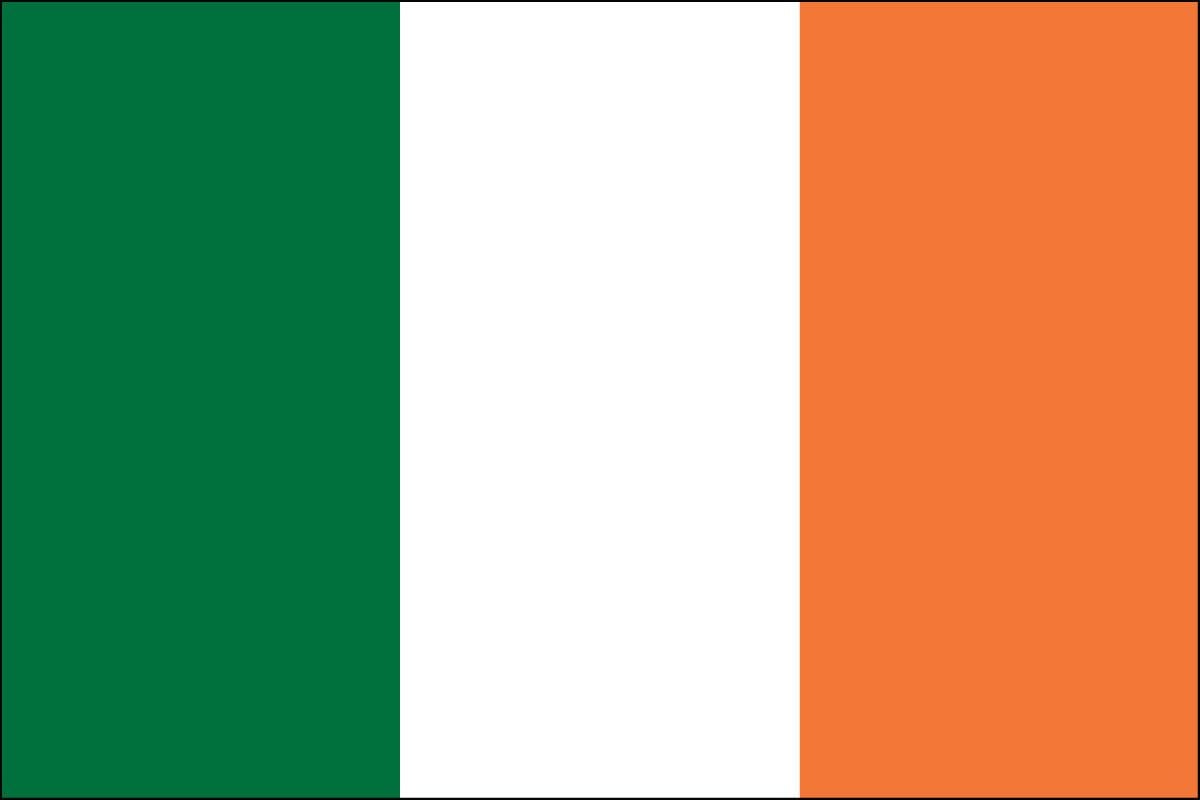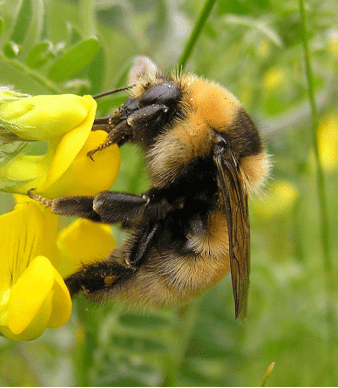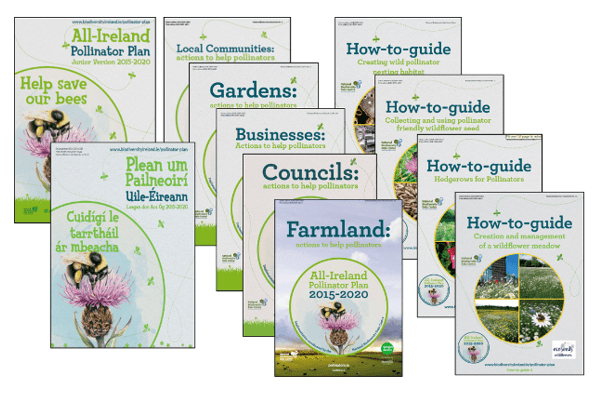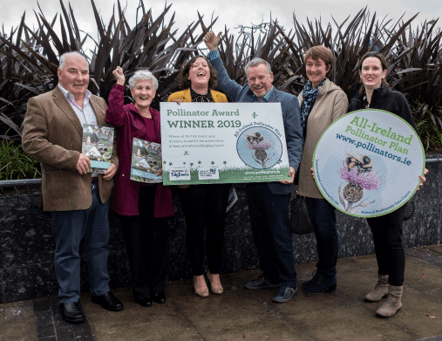Ireland
The All-Ireland Pollinator Plan was launched in 2015, and was an important motivation for Ireland to consider membership of Promote Pollinators. Ireland officially joined Promote Pollinators in 2018 at IPBES-6 in Medellin, Colombia.

Why did Ireland decide to join the coalition?
The All-Ireland Pollinator Plan was launched in 2015, and was an important motivation to Ireland officially joining Promote Pollinators at the Intergovernmental Platform on Biodiversity and Ecosystem Services IPBES 6th plenary in Medellin, Colombia. The All-Ireland Pollinator Plan meant that many steps were already being taken to help pollinators across the island, and there was already much public awareness of the importance of pollination services and the need to address declines in pollinators.
By signing up to the Coalition on 21 March 2018 (along with Bosnia and Herzegovina, Dominican Republic, Mexico and Colombia), Ireland joined the existing 15 partners (Austria, Belgium, Denmark, Ethiopia, Finland, France, Germany, Luxemburg, Peru, Slovenia, Slovakia, Spain, The Netherlands, United Kingdom, Uruguay) and has committed to:
- taking action to protect pollinators and their habitats by developing and implementing national pollinator strategies, consistent with the Intergovernmental Platform on Biodiversity and Ecosystem Services (IPBES) thematic assessment on pollinators, pollination and food production;
- sharing experience and lessons learnt in developing and implementing national pollinator strategies, especially knowledge on new approaches, innovations and best practices;
- reaching out to seek collaboration with a broad spectrum of stakeholders;
- developing research on pollinator conservation;
- mutual support and collaboration.
Ireland already meets many of these commitments via the All-Ireland Pollinator Plan, which aims to:
- Make Ireland pollinator friendly (on farmland, public land & private land)
- Raise awareness of pollinators and how to protect them
- Manage pollinators appropriately – support beekeepers and growers
- Expand our knowledge on pollinators and pollination service
- Collect evidence to track change and measure success
The situation in Ireland
Irish pollinators are in decline. The problem is serious and requires immediate attention to ensure the sustainability of our food, avoid additional economic impact on the agricultural sector, and protect the health of the environment. It has recently been estimated that the global loss of pollinators would cost the world’s economy a trade deficit of €260 billion to €1.11 trillion per year! In the UK and Ireland, pollination services have been estimated to annually contribute £322.10 million and up to €59 million to the respective economies. In Ireland, this estimate increases to a loss between €150–840 million per annum when imported animal-pollinated goods are considered. More regionally, pollination services provided to oilseed rape in RoI are valued at €3.9 million per year. In NI, the value of pollination services for apple trees is thought to be around £7 million annually.
Three-quarters of our wild plants also require insect pollinators, meaning that without them our landscape would be a very different place. Their value from a tourism and branding perspective is of particular relevance in Ireland, but this has never been assessed in a monetary sense.
Ireland has 98 native bee species, half of which have undergone substantial declines since the 1980s. One third of our wild bees are now threatened with extinction (6 species are critically endangered; 10 endangered; and 14 vulnerable). The Bumblebee Monitoring Scheme has shown abundance of common bumblebees has declined by 14% since 2012.
Pollinator declines are attributed to five main factors: habitat loss, general declines in wildflowers, disease, pesticide use, and our changing climate. Experts commonly agree that the loss of floral resources in the agricultural landscape has been a key driver. Declines in wildflowers are largely due to changing farming practice, particularly the movement from hay to silage production. Our tendency to tidy up the landscape rather than allowing wildflowers to grow along roadsides, field margins, and in parks and gardens is also playing a role in fewer of these resources being available.

The Great Yellow Bumblebee (Bombus distinguendus) is in decline across Europe, with populations falling by more than 30% over the past 10 years. In Ireland, the Great Yellow Bumblebee was never common, but it was found across the island prior to 1960. Currently, healthy populations are known only from the Mullet peninsula in County Mayo. It is listed as Endangered in the Irish Regional Red List of Bees (2006) and as Vulnerable in the European Red List of Bees (2014).
How is Ireland working with its national strategy?
To address the problem, the All-Ireland Pollinator Plan was initiated in 2015 by Úna FitzPatrick and Jane Stout and then developed by a 15-member steering group, representative of key stakeholders. The Plan was developed from the ground up and is entirely voluntary.
At its core, it is about providing food and shelter across all types of land so that Irish pollinators can survive and thrive. It is a shared plan of action. It is about coming together to work strategically and cohesively over the period 2015-2020, so that collectively we can take steps to reverse pollinator losses and help restore populations to healthy levels. The Plan identifies 24 targets and 81 actions in total. A large focus of the Plan is to identify actions to improve the quality and amount of diverse and flower-rich habitat across Ireland. This will benefit all pollinating insects. These range from creating pollinator highways along our transport routes, to supporting pollinators through agri-environment schemes and encouraging the public to see their gardens as potential pit-stops for bees. The Plan is also about raising awareness on pollinators and how to protect them. It aims to ensure that everyone – from schools, to farmers, to local authorities, to gardeners and businesses – know what pollinators need and what simple cost-effective actions they can take to help.
On publication, 69 organisations agreed to support the Plan, many of whom have accepted responsibility for specific actions. These organisations range from Local Authorities, to State Agencies and NGOs. This number of supporting partners has since risen to over 100.There was a concerted effort to make sure that all messaging was positive, constructive and celebrated the biodiversity we have. We aimed to be very clear on what the plan was asking people to do. Actions provided are always evidence-based and carefully tailored to each target audience. All information was made freely available, easily accessible, using existing channels and networks for each sector.

One of the tenets of the All-Ireland Pollinator Plan was to track progress in a very open and transparent way. An annual review was published at the end of each year, and a mid-term review was published in 2018.
The Plan is project managed on a part-time basis by Dr Úna FitzPatrick within her current role as Senior Ecologist in the National Biodiversity Data Centre (1.25 days/week). Between 2016-2019 Bord Bia and the Heritage Council co-funded one project officer position. The Plan doesn’t have a project budget, but from 2016-2019 DAFM provided €15,000 annually and this has been invaluable in allowing the publication of resources and outreach material.

Geashill Tidy Towns won the national Tidy Towns Local Authority Pollinator Award for small town/village in 2019. Local Communities have really been front and centre in supporting the All-Ireland Pollinator Plan, with hundreds of towns and villages across the island creating pollinator-friendly sites.
Successes to date (end December 2019)
- As of the end of year 4 (Dec 2019), 96% of the 81 actions in the AIPP have been completed.
- Evidence-based resources have been developed for all sectors and are freely available at pollinators.ie
- Across all sectors the number of individuals and organisations engaging with the Plan and taking actions continues to increase.
- To date more than 1,300 individual sites have been logged on the online mapping system ‘Actions for Pollinators’.
- Biodiversity Ireland has received European Innovation Partnership funding through DAFM for a large project on ‘Protecting Farmland Pollinators’ (2019-2023).
- Most Local Authorities across the island have engaged with the Pollinator Plan and are taking actions on the land they manage. As of 2019, 40% of all Councils have already signed up as a formal partner.
- Within RoI, 162 different local communities have now entered the special Tidy Towns pollinator award and made their local area more pollinator friendly.
- The number of companies who have signed up as business supporters of the AIPP now stands at 210 and far exceeds the original target set in the 2015 Plan.
- Since its publication, the Pollinator Plan has been promoted via more than 450 published articles, interviews, and other events.
- An action in the recent EU Pollinator Initiative (2018) is to encourage all Member States to develop national pollinator strategies and they have decided to use the AIPP as the template.
Acknowledgements
Acknowledgements are extended to the 15-member All-Ireland Pollinator Plan steering group who developed and oversee implementation of the Plan. We also thank all those council partners, business supporters, farming and local communities, and Pollinator Plan champions across all sectors who have embraced the Plan and are working to make real changes for the better.
Ireland’s tips:
The success of the All-Ireland Pollinator Plan was generated from communities and individuals getting behind the plan and causing a surge of positive actions from the bottom up. Our tips to other members would include:
- Plan your message carefully – it should be clear and simple.
- Collectively agree a realistic framework for the future.
- Work together as much as possible.
- Be open to evolving, adapting and learning.
- It is the intention of the AIPP to develop an online toolkit for other countries interested in adopting a similar approach
What are Ireland’s expectations for the future?
Despite minimal funding, as we reach the final year of the first phase of the All-Ireland Pollinator Plan, there is no doubt that is has been a success. However, it is time to take stock and see what lessons can be learned. We also need to look further afield to learn from international experiences in recent years.
We hope the adoption of actions continues to grow across all sectors. There is a long way to go, but successes to date have been more than could have been imagined when the plan was first published in October 2015. Ultimately the aim has always been that we begin to record increases in bee populations through our monitoring schemes.
We are looking forward to the 2021-2025 version of the All-Ireland Pollinator Plan; together we can make the next phase as ambitious as possible.
Do you want to know more about Ireland’s efforts? Or do you want to get in touch?
Please contact pollinators@biodiversityireland.ie
Downloads
-
All resources, publications, videos, presentations and animations are free to download at www.pollinators.ie
